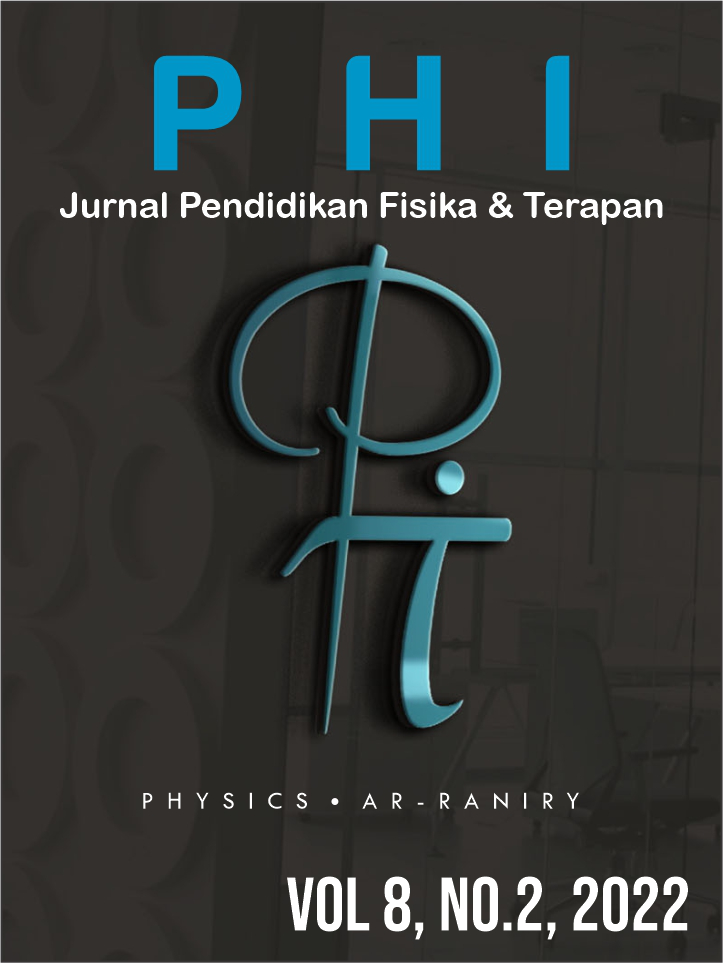Optimasi Serat Selulosa Asetat/Gelatin/Ekstrak Bajakah (Spatholobus littoralis Hassk) menggunakan Pemintalan Elektrik (Electrospinning)
DOI:
https://doi.org/10.22373/p-jpft.v8i2.15760Keywords:
electrospinning, bajakah (Spatholobus littoralis Hassk), nanoseratAbstract
Pemintalan elektrik (electrospinning) merupakan metode produksi serat yang efektif dan efisien, yang dapat menggunakan berbagai jenis material dan dimanfaatkan untuk beragam aplikasi, salah satunya sebagai media penghantar. Bajakah (Spatholobus littoralis Hassk) merupakan tanaman asli Indonesia yang tinggi akan zat antioksidan dan anti inflamasi. Pada penelitian ini, ekstrak etanolik bajakah diinkorporasikan ke dalam serat selulosa asetat (SA)/gelatin dengan memvariasikan perbandingan volume larutan polimer (SA/gelatin) terhadap larutan ekstrak bajakah (8:1, 6:1, 4:1, dan 2:1). Berdasarkan hasil electrospinning diperoleh bahwa hanya larutan prekursor SA/gelatin 2:1 yang tidak dapat menghasilkan serat. Hasil analisis data karakterisasi SEM menunjukkan bahwa larutan prekursor SA/gelatin dan SA/gelatin/bajakah 8:1, 6:1, 4:1 berturut-turut menghasilkan serat dengan ukuran rata-rata sebesar 1548, 1509, 1377, dan 1079 nm. Uji kadar ekstrak bajakah menggunakan UV-Vis menunjukkan bahwa ekstrak bajakah berhasil diinkorporasikan dalam serat SA/gelatin.References
Andrady, A. L. 2008. Science and technology of polymer nanofibers. New Jersey, John Wiley and Sons.
Ariesanti, Y., Poedjiastoeti, W., Komariah, dan Wijaya, A. F. 2021. In Vitro Wound Healing Potential of Stem Extract of Spatholobus littoralis Hassk. Journal of International Dental and Medical Research. Vol 14 (4), 1379-1385.
Hu, X., Liu, S., Zhou, G., Huang, Y., Xie, Z., dan Jing, X. 2014. Electrospinning of polymeric nanofibers for drug delivery applications. Journal of Controlled Release. Vol 185, 12-21.
Iskandar, D. dan Warsidah. 2020. Qualitative Phytochemical Screening and Antioxidant Activity of Ethanol Root Extract of Spatholobus littoralis Hassk. The Journal of Food and Medicinal Plants, Vol 1(1), 13-15.
Konwarh, R., Karak, N., dan Misra, M. 2013. Electrospun cellulose acetate nanofibers: The present status and gamut of biotechnology application. Biotechnology Advances. Vol 31, 421-437.
Kusumah, F. H., Sriyanti, I., Edikresnha, D., Munir, M. M., dan Khairurrijal. 2017. Simply electrospun gelatin/cellulose acetate nanofibers and their physico-Chemical characteristics. Materials Science Forum, Vol 880, 95-98.
Lu, Y., Huang, J., Yu, G., Cardenas, R., Wei, S., Wujcik, E. K., dan Guo, Z. 2016. Coaxial electrospun fibers: applications in drug delivery and tissue engineering. WIREs Nanomed Nanobiotechnol. Vol 8, 654-677.
Munir, M. M., Suryamas, A. B., Iskandar, F., dan Okuyama, K. 2009. Scaling law on particle-to-fiber formation during electrospinning. Polymer. Vol 50, 4935-4943.
Ramakrishna, S., Fujihara, K., Teo, W. E., Lim, T. C., dan Ma, Z. 2005. An introduction to electrospinning and nanofibers. Singapore, World Scientific.
Ramakrishna, S., Fujihara, K., Teo, W. E., Yong, T., Ma, Z., dan Ramaseshan, R. 2006. Electrospun nanofibers: solving global issues. Materials Today. Vol 9, 40-50.
Saputera, M. M. A. dan Ayuchecaria, N. 2018. Uji Efektivitas Ekstrak Etanolik Batang Bajakah Tampala (Spatholobus littoralis Hassk.) terhadap Waktu Penyembuhan Luka. Jurnal Ilmiah Ibnu Sina. Vol 3(2), 318-327.
Wei, Q., Xu, F., Xu, X., Geng, X., Ye, L., Zhang, A., dan Feng, Z. 2016. The multifuncion wound dressing with core-shell structured fibers prepared by coaxial electrospinning. Frontier of Material Science. Vol 10, 113-121.
Weng, L. dan Xie, J. 2015. Smart electrospun nanofibers for controlled drug release: Recent advance and new perspectives. Current Pharmaceutical Design. Vol 21, 1-16.
Zhang, Y. Z., Wang, X., Feng, Y., Li, J., Lim, C. T., dan Ramakrisnha, S. 2006. Coaxial Electrospinning of (Fluorescein Isothiocyanate-Conjugated Bovine Serum Albumin)-Encapsulated Poly(E-caprolactone) Nanofibers for Sustained Release. Biomacromol. Vol 7, 1049-1057.
Downloads
Published
Issue
Section
License
Authors who publish with Jurnal Phi agree to the following terms:
- Authors retain copyright and grant the journal right of first publication with the work simultaneously licensed under a Creative Commons Attribution License (CC BY 4.0) that allows others to share the work with an acknowledgment of the work's authorship and initial publication in this journal.
- Authors are able to enter into separate, additional contractual arrangements for the non-exclusive distribution of the journal's published version of the work (e.g., post it to an institutional repository or publish it in a book), with an acknowledgment of its initial publication in this journal.
- Authors are permitted and encouraged to post their work online (e.g., in institutional repositories or on their website) prior to and during the submission process, as it can lead to productive exchanges, as well as earlier and greater citation of published work (See The Effect of Open Access).

















